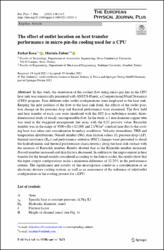| dc.contributor.author | Koca, Ferhat | |
| dc.contributor.author | Zabun, Mustafa | |
| dc.date.accessioned | 2022-05-11T08:12:17Z | |
| dc.date.available | 2022-05-11T08:12:17Z | |
| dc.date.issued | 2021 | tr |
| dc.identifier.citation | Faculty of Technology, Department of Automotive Engineering, Sivas Cumhuriyet University,
58140 Campus, Sivas, Turkey
2 Faculty of Engineering, Department of Mechanical Engineering, Yeditepe University, ˙Istanbul, Turkey | tr |
| dc.identifier.uri | https://link.springer.com/article/10.1140/epjp/s13360-021-02113-4 | |
| dc.identifier.uri | https://hdl.handle.net/20.500.12418/12776 | |
| dc.description.abstract | In this study, the simulation of the coolant flow using micro-pin fins in the CPU
heat sink was numerically presented with ANSYS-Fluent, a Computational Fluid Dynamics
(CFD) program. Four different inlet–outlet configurations were employed in the heat sink.
Keeping the inlet position of the flow to the heat sink fixed, the effects of the outlet position change on the pressure drop and thermal performance were examined. The flow field
and heat transfer of each case were simulated with the SST k-ω turbulence model, threedimensional study of steady, incompressible flow. In the study, a 2 mm diameter copper tube
was used in the staggered arrangement fins array with the 0.23 porosity value. Reynolds
number was in the range of 5000 < Re < 12,000 and 2 kW/m2 constant heat flux to the cooling base was taken into consideration boundary conditions. Velocity streamlines, TKE and
temperature distributions, Nusselt number (Nu), skin friction values (f), pressure drop (P),
thermal resistance (Rth) and performance criterion (PEC) changes were presented to detail
the hydrodynamic and thermal performance characteristics along the heat sink surface with
the increase of Reynolds number. Results showed that as the Reynolds number increased,
Nusselt number increased and skin friction decreased. In addition to the improvement in heat
transfer for the finned models considered according to the finless cooler, the results show that
the input–output configurations make a minimum difference of 32.25% in the performance
criteria. The significance and novelty of this investigation consist in a consideration of an
electronic devices cooling system, as well as an assessment of the influence of inlet/outlet
configuration on the cooling process for a CPU. | tr |
| dc.language.iso | eng | tr |
| dc.relation.isversionof | 10.1140/epjp/s13360-021-02113-4 | tr |
| dc.rights | info:eu-repo/semantics/closedAccess | tr |
| dc.subject | Sink | tr |
| dc.subject | Nanofluid | tr |
| dc.subject | Flow | tr |
| dc.subject | Optimization | tr |
| dc.title | The effect of outlet location on heat transfer performance in micro pin-fin cooling used for a CPU | tr |
| dc.type | article | tr |
| dc.relation.journal | European Physical Journal Plus | tr |
| dc.contributor.department | Teknoloji Fakültesi | tr |
| dc.contributor.authorID | 0000-0001-8849-5295 | tr |
| dc.identifier.volume | 136 | tr |
| dc.identifier.issue | 11 | tr |
| dc.relation.publicationcategory | Uluslararası Hakemli Dergide Makale - Kurum Öğretim Elemanı | tr |















